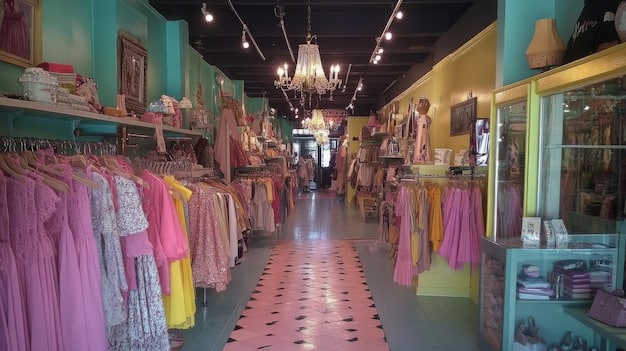Sustainable Style: Eco-Friendly Outfit Ideas for Your Wardrobe

Anúncios
Sustainable style involves curating an eco-friendly wardrobe by choosing ethically produced, durable clothing, embracing second-hand finds, and making conscious decisions to reduce fashion’s environmental impact for a more sustainable lifestyle.
Anúncios
Creating a sustainable style doesn’t mean sacrificing fashion; it’s about making informed choices. Explore outfit ideas for building an eco-friendly wardrobe, blending ethics and aesthetics seamlessly.
What is Sustainable Fashion and Why Does it Matter?
Sustainable fashion is more than just a trend; it’s a movement towards reducing the environmental and social impact of the clothing industry. It encompasses the entire lifecycle of a garment, from raw material extraction to disposal.
Anúncios
Understanding why sustainable fashion matters is crucial. The fast fashion industry contributes significantly to pollution, resource depletion, and unethical labor practices.
Environmental Impact of Fast Fashion
Fast fashion’s rapid production cycles and low prices encourage overconsumption, leading to textile waste and environmental degradation.
Social Impact of the Fashion Industry
Many fast fashion brands rely on exploitative labor practices in developing countries, where workers often face unsafe conditions and unfair wages.
- Choosing eco-friendly materials like organic cotton and recycled fabrics.
- Supporting brands with transparent and ethical supply chains.
- Extending the lifespan of your clothes through proper care and repair.
- Reducing textile waste by donating or recycling unwanted items.
By understanding the impact of our fashion choices, we can make more responsible decisions. Supporting brands that prioritize sustainability and adopting mindful consumption habits are essential steps toward a more ethical and eco-friendly wardrobe.
Curating a Capsule Wardrobe with Sustainable Pieces
A capsule wardrobe consists of a limited number of versatile clothing items that can be mixed and matched to create a variety of outfits. Building a sustainable capsule wardrobe helps minimize waste and encourages mindful consumption.
Selecting timeless staples and consciously choosing eco-friendly and ethically made items are key to curating a sustainable capsule wardrobe.

Essential Sustainable Staples
Focus on building a foundation of versatile, high-quality pieces that can be styled in various ways.
Choosing Eco-Friendly Fabrics
Opt for sustainable materials like organic cotton, linen, hemp, Tencel, and recycled fabrics to reduce your wardrobe’s environmental footprint.
- A classic white t-shirt made from organic cotton.
- A pair of well-fitting, ethically produced denim jeans.
- A versatile blazer crafted from recycled materials.
- A comfortable knit sweater made from eco-friendly wool or cashmere.
By carefully selecting essential staples and prioritizing eco-friendly fabrics, you can create a stylish and sustainable capsule wardrobe. This approach not only reduces waste but also promotes a more conscious and intentional approach to fashion.
Outfit Ideas for a Sustainable Wardrobe: Day-to-Night Looks
Creating versatile outfits that can transition from day to night is a great way to maximize your sustainable wardrobe’s potential. This approach minimizes the need for excessive clothing and encourages creative styling.
With a few key pieces and the right accessories, you can create stylish and eco-conscious looks suitable for various occasions.
Casual Daytime Outfit
A simple yet chic daytime look can be achieved with a few sustainable staples.
Elegant Evening Ensemble
Transform your daytime outfit into an elegant evening ensemble with the right styling choices.
- Pair a sustainable linen dress with sandals and a tote bag for a relaxed daytime look.
- Add a denim jacket made from recycled cotton for a touch of casual cool.
- Accessorize with a minimalist necklace made from recycled materials.
- Swap sandals for heels and add a statement clutch for an elevated evening look.
By leveraging versatile pieces and sustainable accessories, you can create various day-to-night outfits with minimal environmental impact. Embrace creative styling and conscious choices to express your personal style while promoting sustainability.
Thrifting and Vintage Shopping: Outfit Inspiration
Thrifting and vintage shopping are excellent ways to find unique, sustainable pieces while giving pre-loved clothing a new life. These practices reduce textile waste and offer an alternative to fast fashion.
Exploring thrift stores and vintage boutiques can lead to exciting discoveries and inspire creative outfit combinations.

Finding Unique Pieces
Thrift stores and vintage shops often carry one-of-a-kind items that add character and personality to your wardrobe.
Creating Vintage-Inspired Outfits
Incorporate vintage finds into your modern wardrobe to create stylish and sustainable looks.
- Look for vintage denim jackets and pair them with modern dresses for a stylish contrast.
- Find unique scarves and accessories to add a pop of color and personality to your outfits.
- Repurpose vintage dresses by altering them to fit your style and body shape.
- Mix vintage pieces with contemporary items to create a timeless and sustainable wardrobe.
Thrifting and vintage shopping offer endless possibilities for creating sustainable and stylish outfits. Embrace the thrill of the hunt and the satisfaction of giving pre-loved clothing a new life while reducing your environmental footprint.
Accessorizing Sustainably: Ethical Jewelry and Bags
Choosing sustainable accessories is just as important as selecting eco-friendly clothing. Accessories can complete an outfit and express your personal style without compromising your values.
Ethical jewelry and bags made from sustainable materials are excellent choices for enhancing your sustainable wardrobe.
Ethical Jewelry Options
Look for jewelry made from recycled metals, ethically sourced gemstones, or upcycled materials.
Sustainable Bag Choices
Opt for bags made from organic cotton, recycled materials, or innovative plant-based alternatives.
- Choose a tote bag made from organic cotton for everyday use.
- Invest in a stylish handbag made from recycled materials.
- Wear a necklace made from ethically sourced gemstones.
- Choose earrings crafted from recycled metals.
By selecting ethical jewelry and sustainable bags, you can elevate your outfits while supporting responsible production practices. These conscious choices contribute to a more sustainable and ethical fashion industry.
Caring for Your Clothes to Extend Their Life
Proper care and maintenance can significantly extend the lifespan of your clothing, reducing the need for frequent replacements. This practice is essential for building a sustainable wardrobe.
Adopting simple habits like washing clothes less often, using eco-friendly detergents, and repairing damaged items can make a big difference.
Washing Clothes Less Often
Over-washing can damage fabrics and contribute to water waste. Only wash clothes when they are visibly dirty or smelly.
Using Eco-Friendly Detergents
Conventional detergents often contain harsh chemicals that can harm the environment. Opt for eco-friendly alternatives.
- Wash clothes in cold water to conserve energy and prevent color fading.
- Avoid using harsh chemicals and bleach.
- Air-dry clothes to reduce energy consumption and prolong their lifespan.
- Repair damaged items instead of discarding them.
By implementing proper care practices, you can extend the life of your clothes and reduce your environmental impact. These simple habits contribute to a more sustainable and responsible approach to fashion.
| Key Point | Brief Description |
|---|---|
| ♻️ Eco-Friendly Fabrics | Choose materials like organic cotton and recycled polyester. |
| 🛍️ Capsule Wardrobe | Opt for versatile items that can be mixed and matched easily. |
| 🧵 Clothing Care | Wash clothes less often and use eco-friendly detergents. |
| 💎 Ethical Accessories | Select jewelry and bags made from sustainable materials. |
FAQ
▼
Sustainable fashion focuses on minimizing the environmental and social impact of the clothing industry. It involves ethical production, eco-friendly materials, and conscious consumption.
▼
Start by selecting versatile staples made from sustainable materials. Choose items that can be mixed and matched to create multiple outfits. Prioritize quality over quantity.
▼
Eco-friendly fabrics include organic cotton, linen, hemp, Tencel, and recycled materials like recycled polyester. These options have a lower environmental impact compared to conventional fabrics.
▼
Extend the lifespan of your clothes by washing them less often, using eco-friendly detergents, washing in cold water, and air-drying. Repair damaged items instead of discarding them.
▼
Look for sustainable accessories at ethical jewelry stores, eco-conscious boutiques, and online retailers that specialize in sustainable fashion. Check for certifications like Fair Trade and GOTS.
Conclusion
Adopting a sustainable style is a journey that combines fashion with environmental responsibility. By making conscious choices in clothing, accessories, and care, we can reduce our impact on the planet while expressing our personal style. Embrace these outfit ideas and tips to build an eco-friendly wardrobe that reflects your values and contributes to a more sustainable future.






